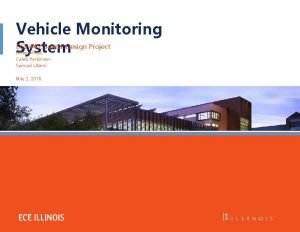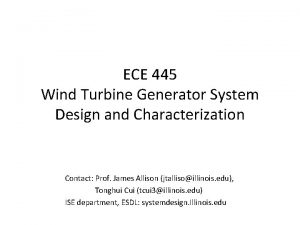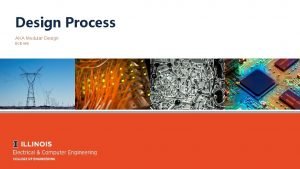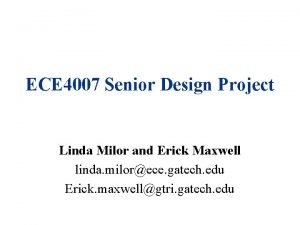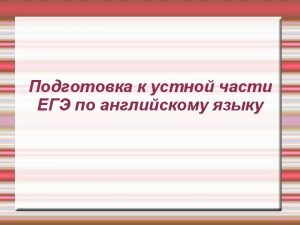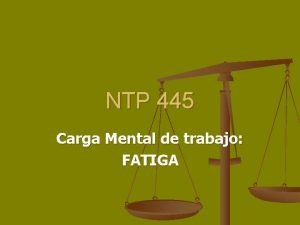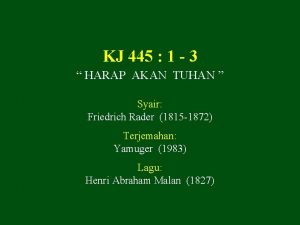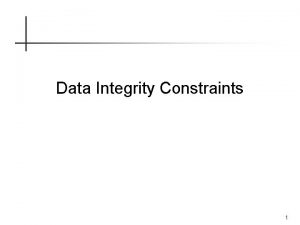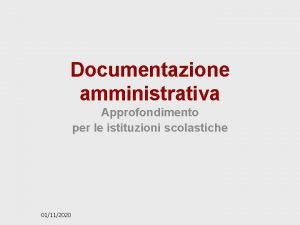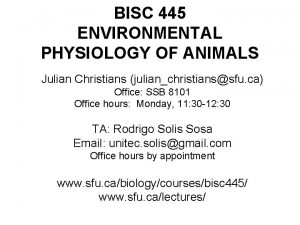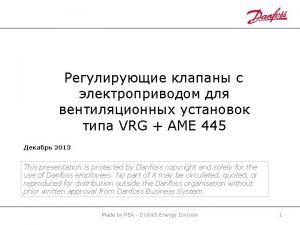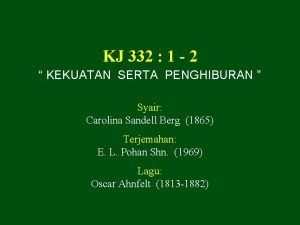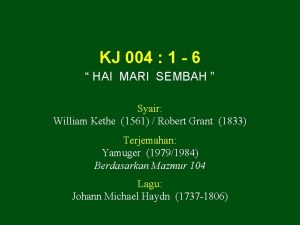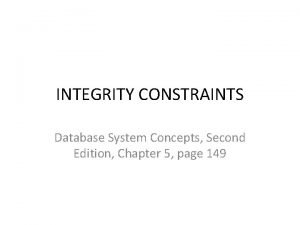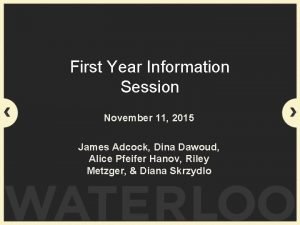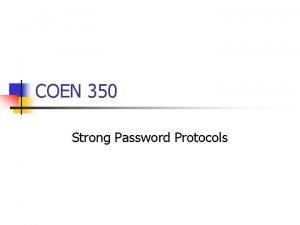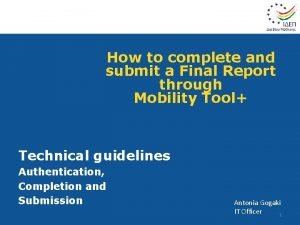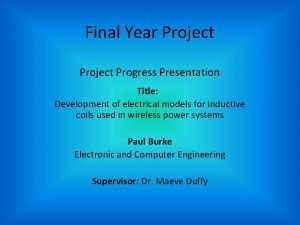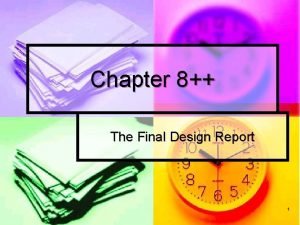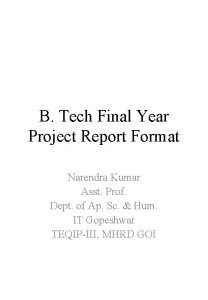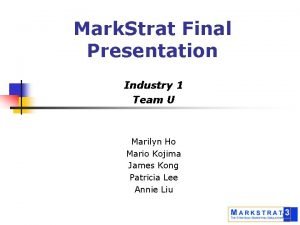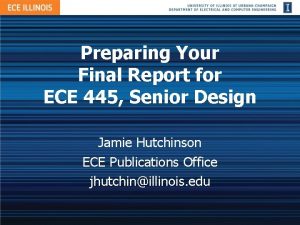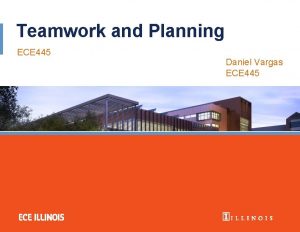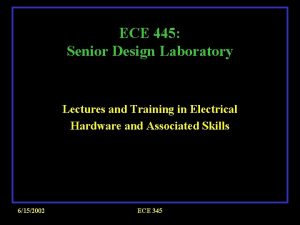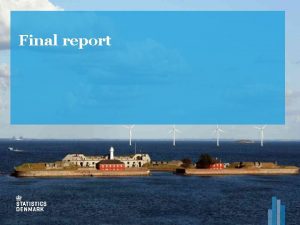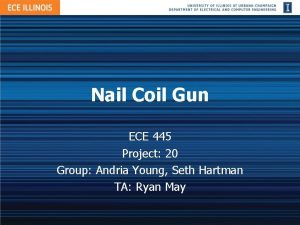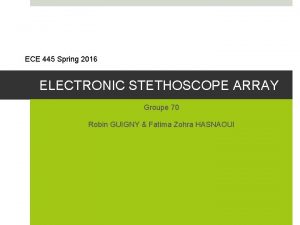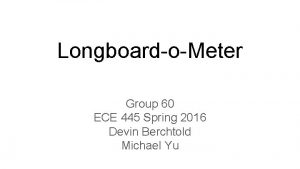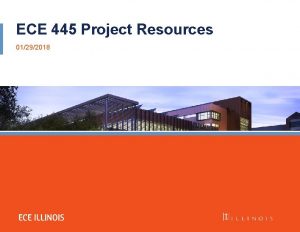Preparing Your Final Report for ECE 445 Senior


































- Slides: 34

Preparing Your Final Report for ECE 445, Senior Design Jamie Hutchinson ECE Editorial Services jhutchin@illinois. edu

Resources on ECE 445 Web Site • Home Guidelines Assignments and Grading Final Report – “Preparing Your Final Report for ECE 445” (final report guidelines) – Word Template (also La. Te. X) – Other resources




















Abstract • Provide 150 words, or less, briefly describing the function and overall design of your project along with main results. • Avoid introductory material such as background, competitors, and motivation —save that for Introduction. • Don’t give a sales pitch. • Do not include in Table of Contents.

Table of Contents • • • Neat and complete Reader-friendly: uses leader dots Accurately reflects headings Accurately reflects page numbers Consistent depth (chapter titles, sections, subsections)

Figures and Tables • Three placement options: – Same page as first citation in text, or first possible page after – Separate section at end of each chapter – Separate chapter (not an appendix) at end of main text

Figures and Tables • Cite every figure and table directly in the text (e. g. : “Figure 1 shows …” not “The following schematic shows …”). • Number figures in order of their citation in text. • Use whole number (1, 2, 3 …) or singledecimal (1. 1, 1. 2, … 2. 1, 2. 2 …) system.

Figures and Tables • Convey the information economically. • Make them neat and legible, and stay within 1 -inch margins. • Label axes, rows, columns. • Write neat, concise captions.

Figures and Tables • As much as possible, anchor them at tops and bottoms of pages with text wrapping. • Do not pin them to text citations, resulting in scattered figures interspersed with short passages of text—as if narrating a slide show.



Appendices • Reserve for detailed technical material that, while it may be important, is secondary or would disrupt the project description of the main text. • Examples: Requirement & verification table (required), large data tables, lengthy code, sets of schematics, etc.

References • Numbered • Neat, complete, consistent • Cited in the text – “According to Smith [1], a major design consideration is …” – “The PIC 16 F 87 A data sheet [1] specifies …”

Miscellaneous • Consistent voice for multiple authors – Use “we, ” not “I, ” “Mary, ” etc. • Pagination – Title page, preliminary pages, main text • Page flow – Start each chapter on new page – Otherwise, avoid big white spaces • Distinguish tables and figures • Avoid “brain dump” with too much detail

Projects 2, 3, 4, 6, 9, 29

Optional Consultation with Editor Jan Progen • Email Jan at progen@illinois. edu to schedule a visit between 2/19 and 3/16.
 Ece 313 uiuc
Ece 313 uiuc Uiuc ece 445
Uiuc ece 445 Vehicle monitoring system project
Vehicle monitoring system project Ece 445
Ece 445 Ece 445
Ece 445 Linda milor
Linda milor Chapter 1 preparing your path to success
Chapter 1 preparing your path to success Imagine that you are preparing a project with your friend
Imagine that you are preparing a project with your friend Ntp 445
Ntp 445 Lirik lagu harap akan tuhan
Lirik lagu harap akan tuhan Artaxerxes decree 457
Artaxerxes decree 457 Artaxerxes decree 445
Artaxerxes decree 445 Integrity constraints types
Integrity constraints types Chapter 15 assessment biology answers page 445
Chapter 15 assessment biology answers page 445 Certificare01
Certificare01 Bisc 445
Bisc 445 Ame 445
Ame 445 Copper tree townhomes
Copper tree townhomes Coen 445
Coen 445 Kj 332 kekuatan serta penghiburan
Kj 332 kekuatan serta penghiburan Klaipeda stockholm
Klaipeda stockholm March 14 445 bc
March 14 445 bc Kj 445
Kj 445 Biba n 445 ddl
Biba n 445 ddl Actsc 445
Actsc 445 Coen 445
Coen 445 Coen 445
Coen 445 Letter to senior self example
Letter to senior self example Welcome to senior year
Welcome to senior year Mobility tool final report
Mobility tool final report Final year project presentation slides
Final year project presentation slides Final design report
Final design report Acknowledgement for b tech final year project
Acknowledgement for b tech final year project Mobility tool webgate login
Mobility tool webgate login Markstrat final report
Markstrat final report


